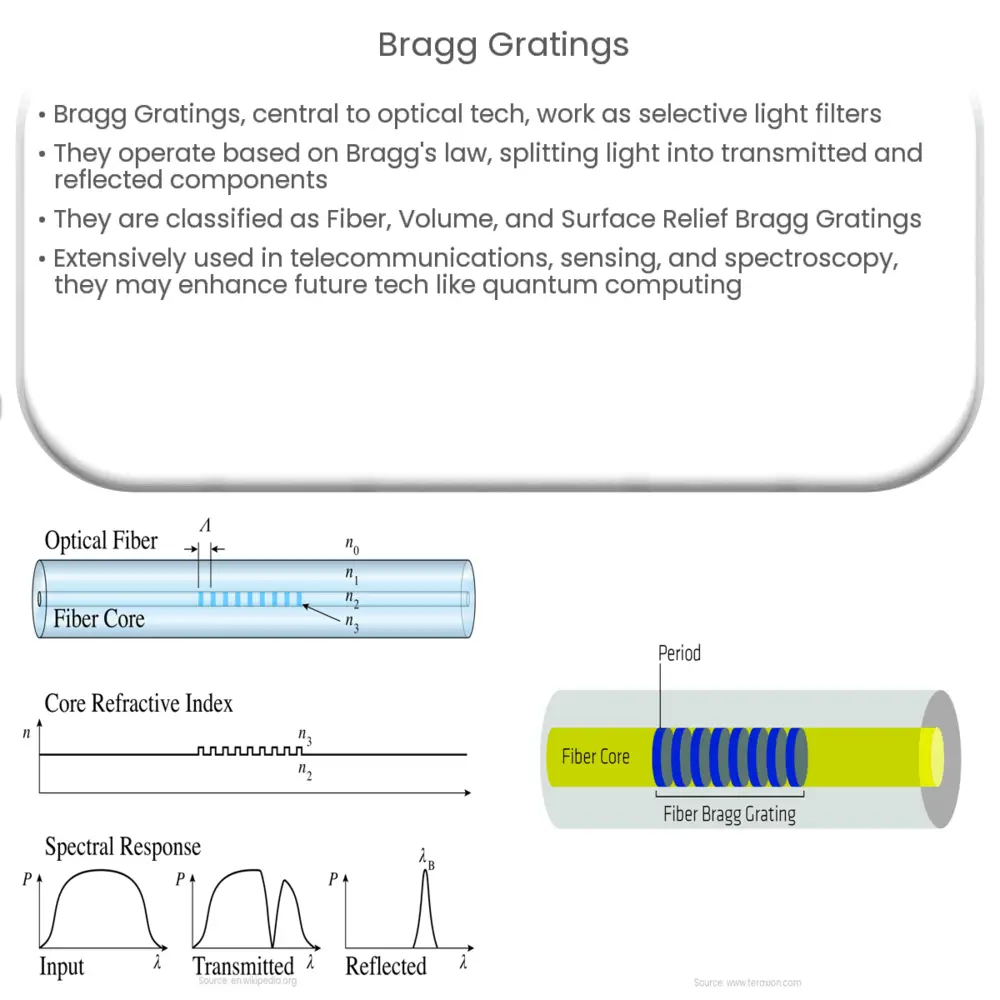Explore the world of Bragg Gratings – their principle, types, applications in telecommunications and sensing, and their promising future.

Introduction to Bragg Gratings
Among the significant innovations in optical technology is the advent of Bragg Gratings. These unique devices, central to numerous applications, are essential components in the modern world of optical communication and sensing.
What are Bragg Gratings?
Bragg Gratings, named after the British scientists William Henry Bragg and his son William Lawrence Bragg, are periodic variations of the refractive index in a dielectric medium, most commonly used in optical fibers. They serve as selective filters of light with a specific wavelength and as reflectors.
Principle of Operation
The basic principle of operation of Bragg Gratings lies in the phenomenon of Bragg’s law, a condition for wave interference that results in the diffraction peaks’ directionality. The incoming light splits into transmitted and reflected components based on their wavelengths when encountering a Bragg grating. A particular wavelength, known as the Bragg wavelength, is reflected while all other wavelengths pass through the grating unaltered. Mathematically, Bragg’s law is represented as:
λB = 2nΛ
Where λB is the Bragg wavelength, n is the average refractive index of the grating, and Λ is the period of the grating.
Types of Bragg Gratings
Bragg Gratings can be broadly classified into three types:
- Fiber Bragg Gratings (FBG): These are formed in a short segment of optical fiber by periodically modifying the fiber’s core refractive index using an intense interference pattern of ultraviolet laser light.
- Volume Bragg Gratings (VBG): Unlike FBGs, VBGs are three-dimensional structures recorded in a photosensitive medium, like a photo-thermo-refractive glass.
- Surface Relief Bragg Gratings (SRBG): These are etched onto the surface of a waveguide and are widely used in applications like optical biosensors and wavelength multiplexing.
Each type of Bragg Grating possesses unique properties that suit different applications, making them versatile tools in the field of optics.
Applications of Bragg Gratings
Bragg Gratings find extensive usage in various domains due to their inherent properties. Let’s take a look at some of these applications:
- Telecommunications: Fiber Bragg Gratings (FBGs) are particularly useful in the field of optical fiber communications for signal filtering, wavelength routing, and dispersion compensation. They are also used in constructing fiber lasers and optical amplifiers.
- Sensing: Bragg Gratings serve as excellent sensors, particularly in monitoring strain, temperature, pressure, and refractive index. This is due to their sensitivity to external conditions, enabling them to detect any changes in their physical parameters.
- Spectroscopy: Volume Bragg Gratings (VBGs) are used in Raman spectroscopy to stabilize lasers and narrow the spectral bandwidth of the laser output.
Future of Bragg Gratings
The advancements in Bragg Grating technology open up vast possibilities in many fields. For instance, there is active research in developing tunable Bragg Gratings that can dynamically adjust their filtering properties. Such developments could significantly enhance telecommunications and sensor technologies, enabling faster data transfer and more precise monitoring systems. Furthermore, emerging fields such as quantum computing and nanotechnology could potentially benefit from more advanced Bragg Grating structures.
Conclusion
In conclusion, Bragg Gratings are integral components in the realm of optics, playing a crucial role in various applications ranging from telecommunications to sensing technologies. Their operating principle, based on Bragg’s law, allows them to selectively filter specific wavelengths, making them versatile and highly efficient tools. With continuous advancements in this field, it is evident that Bragg Gratings will continue to play a pivotal role in the future of optical technology.


